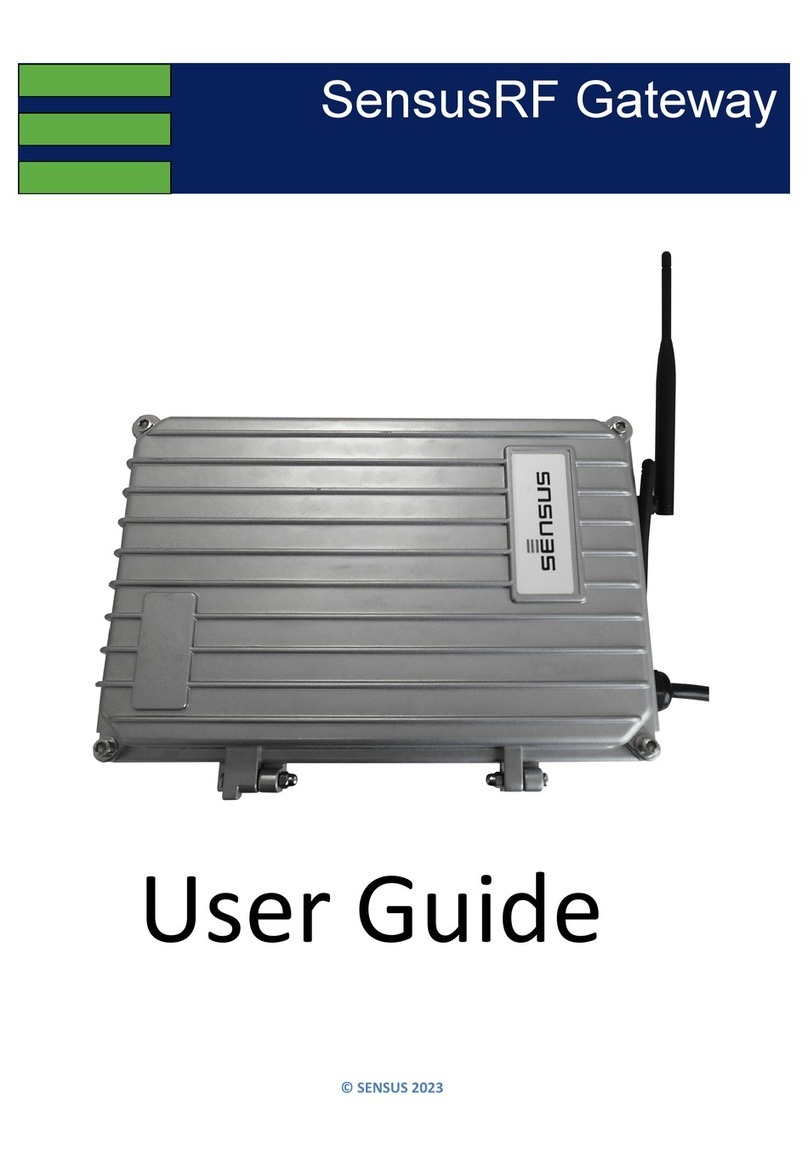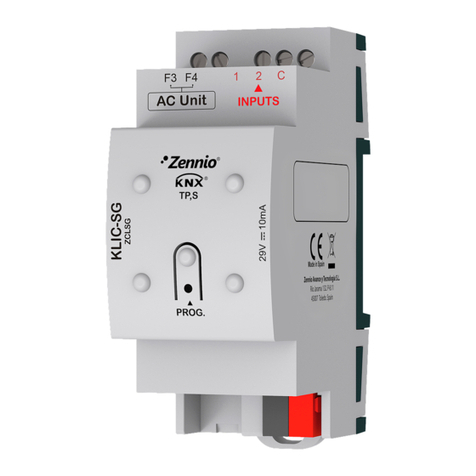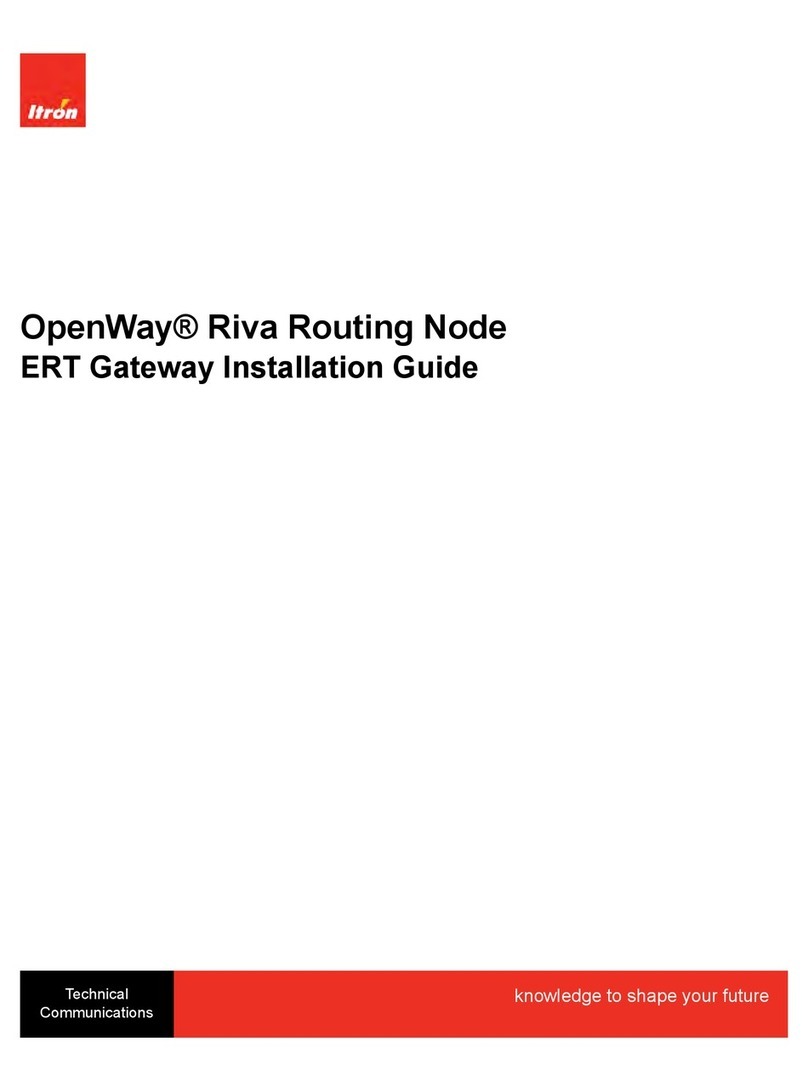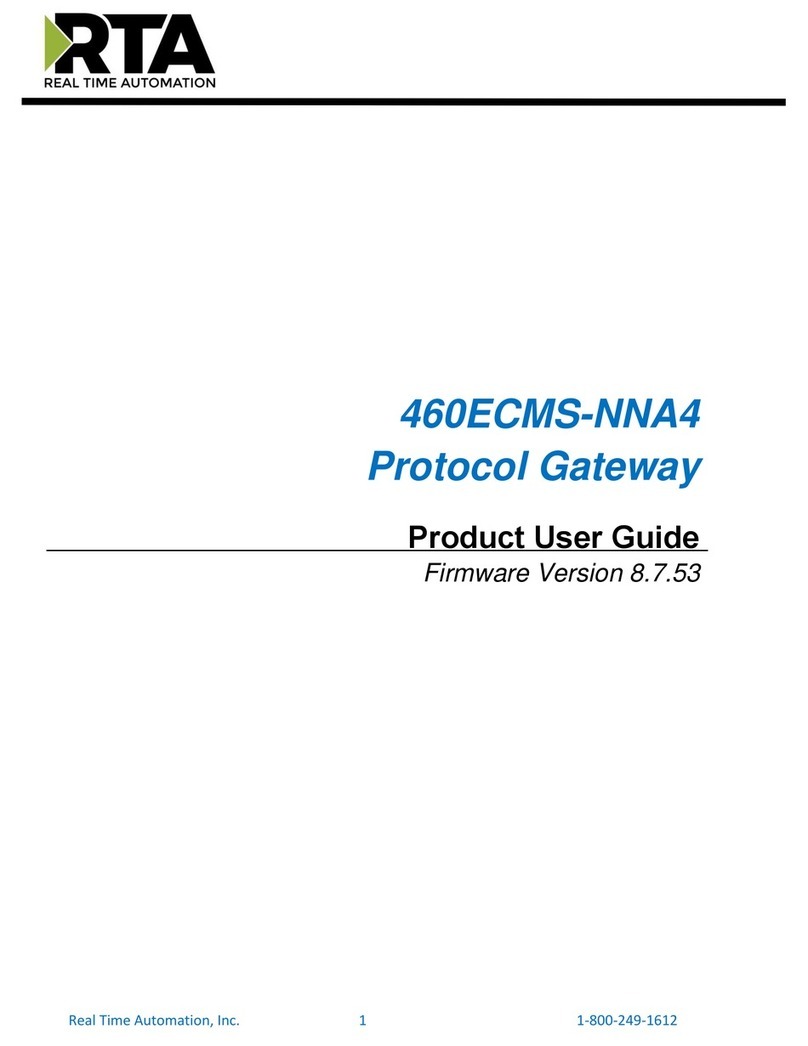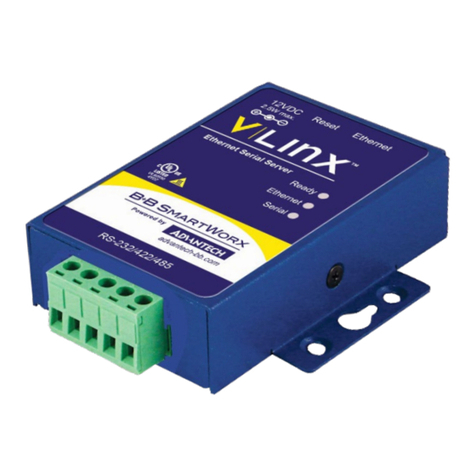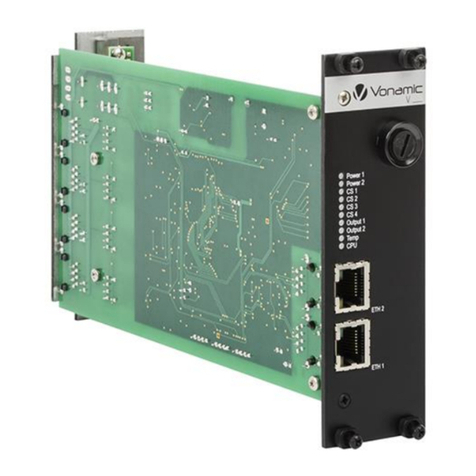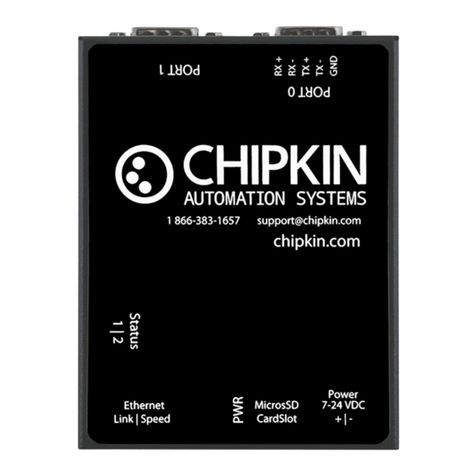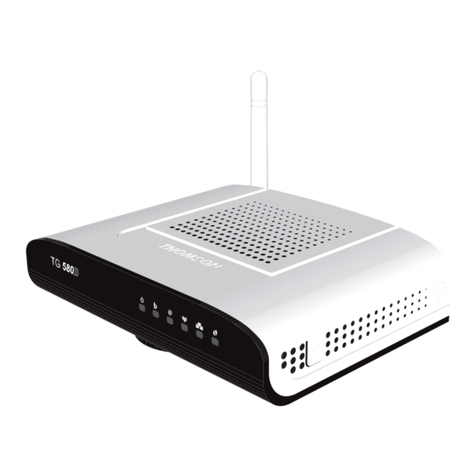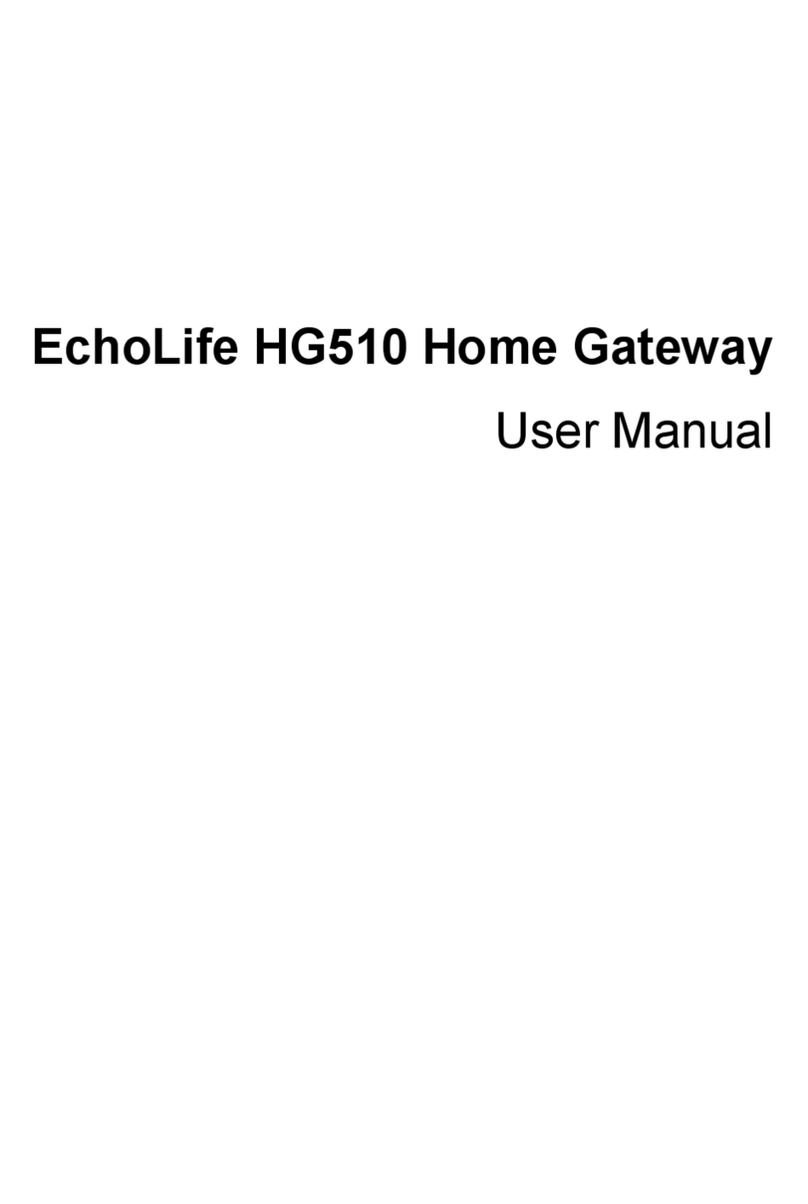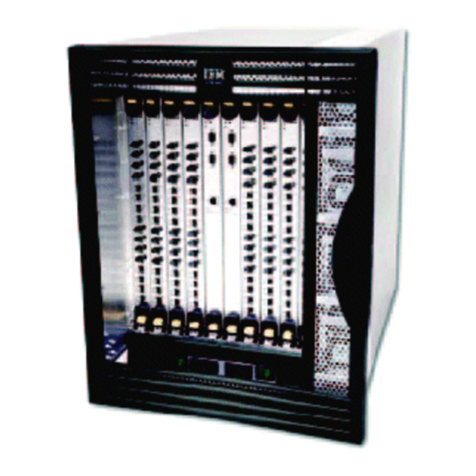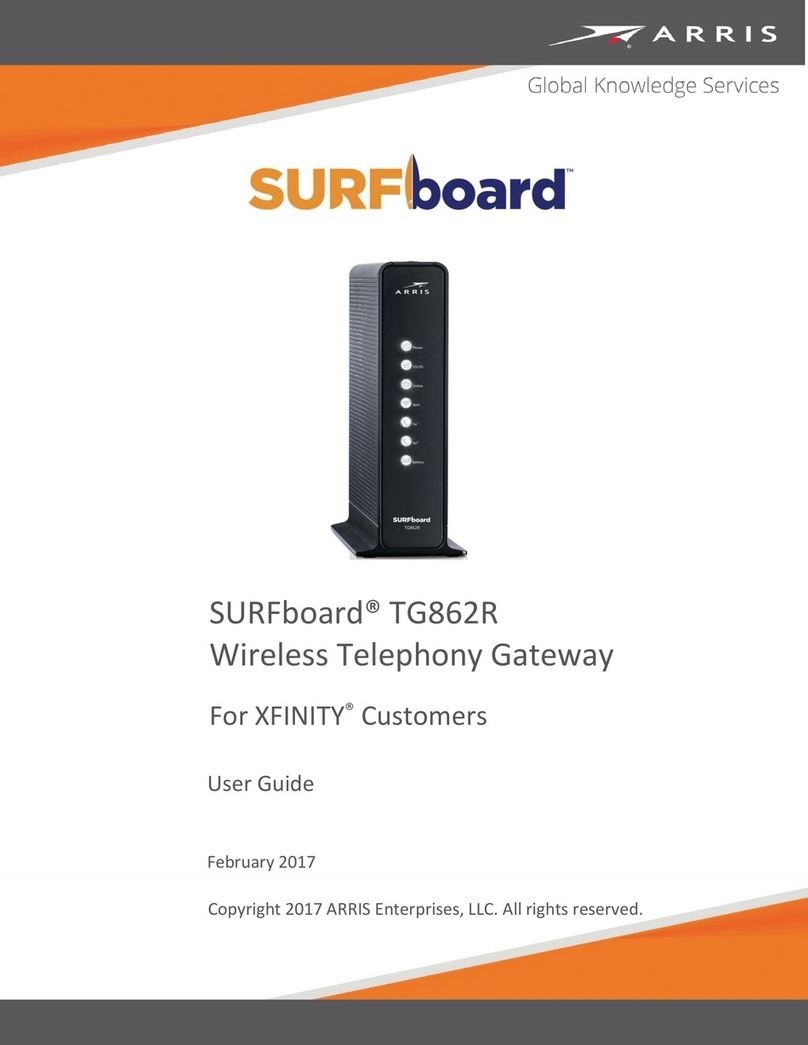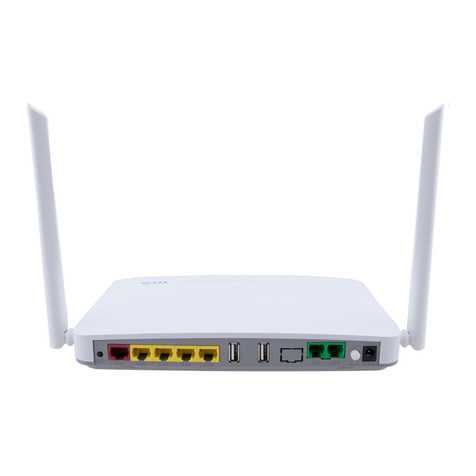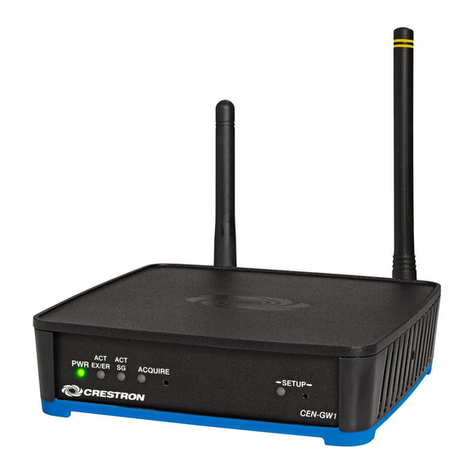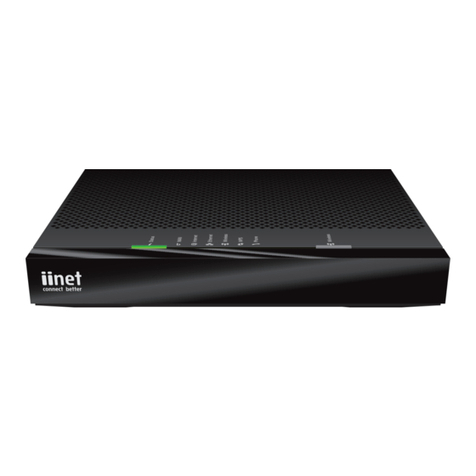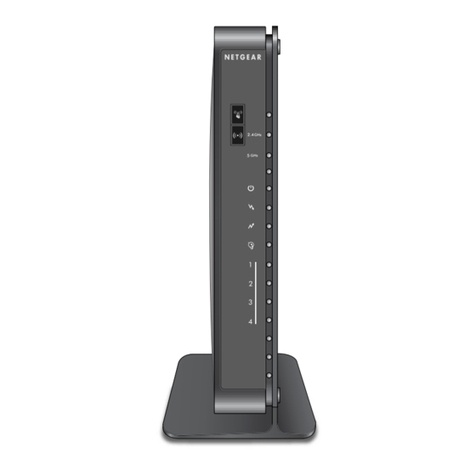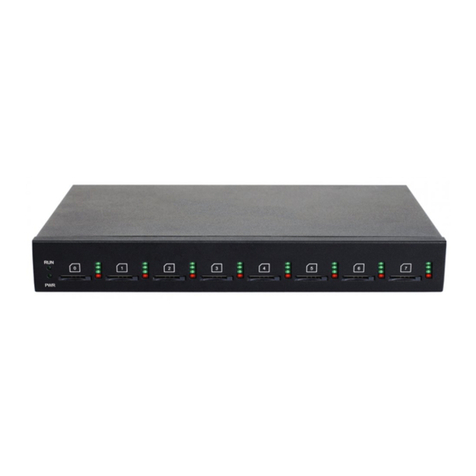Trustwave SWG 3000 User manual

Secure Web Gateway
Version 11.5
Setup Guide
.Trustwave.com Updated October 9, 2007

Secure Web Gateway 11.5 Setup Guide
Copyright © 2013 Trustwave Holdings, Inc. All rights reserved. ii
Legal Notice
Copyright © 2013 Trustwave Holdings, Inc.
All rights reserved. This document is protected by copyright and any distribution, reproduction, copying,
or decompilation is strictly prohibited without the prior written consent of Trustwave. No part of this
document may be reproduced in any form or by any means without the prior written authorization of
Trustwave. While every precaution has been taken in the preparation of this document, Trustwave
assumes no responsibility for errors or omissions. This publication and features described herein are
subject to change without notice.
While the authors have used their best efforts in preparing this document, they make no representation
or warranties with respect to the accuracy or completeness of the contents of this document and
specifically disclaim any implied warranties of merchantability or fitness for a particular purpose. No
warranty may be created or extended by sales representatives or written sales materials. The advice and
strategies contained herein may not be suitable for your situation. You should consult with a professional
where appropriate. Neither the author nor Trustwave shall be liable for any loss of profit or any
commercial damages, including but not limited to direct, indirect, special, incidental, consequential, or
other damages.
The most current version of this document may be obtained by contacting:
Trustwave Technical Support:
Phone: +1.800.363.1621
Email: support@Trustwave.com
Trademarks
Trustwave and the Trustwave logo are trademarks of Trustwave. Such trademarks shall not be used,
copied, or disseminated in any manner without the prior written permission of Trustwave.
Revision History
Version Date Changes
1.0 February 2012 Version 10.2
2.0 October 2012 Version 11.0 update
2.1 November 2013 Version 11.5 update

Secure Web Gateway 11.5 Setup Guide
Copyright © 2013 Trustwave Holdings, Inc. All rights reserved. iii
Formatting Conventions
This guide uses the following formatting conventions to denote specific information.
Formats and Symbols Meaning
Blue Underline A blue underline indicates a Web site or email address.
Bold Bold text denotes UI control and names such as commands, menu items, tab and field
names, button and check box names, window and dialog box names, and areas of
windows or dialog boxes.
Code Text in Lucinda Console indicates computer code or information at a command
line.
Italics
Italics denotes the name of a published work, the current document, name of another
document, text emphasis, or to introduce a new term.
[Square brackets] Square brackets indicate a placeholder for values and expressions.
Notes, Tips, and Warnings
Note: This symbol indicates information that applies to the task at hand.
Tip: This symbol denotes a suggestion for a better or more productive way to use the
product.
Caution: This symbol highlights a warning against using the software in an unintended
manner.
Question: This symbol indicates a question that the reader should consider.

Secure Web Gateway 11.5 Setup Guide
Copyright © 2013 Trustwave Holdings, Inc. All rights reserved. iv
Table of Contents
Legal Notice ii
Trademarks ............................................................................................................................... ii
Revision History ......................................................................................................................... ii
Formatting Conventions iii
Notes, Tips, and Warnings ........................................................................................................ iii
About This Guide v
1Before You Begin 6
2Installing the Appliance 6
2.1 Installing a Physical SWG Appliance .................................................................................. 6
2.1.1 Requirements before Installing a Physical Appliance ............................................... 7
2.1.2 Connecting an Appliance Using an Ethernet Cable .................................................. 7
2.1.2.1 For SWG 3000 and SWG 5000 models: ................................................ 7
2.1.2.2 For an SWG 7000 appliance: ............................................................... 8
2.1.3 Connecting an Appliance Using a Serial Cable ........................................................ 9
2.2 Deploying a Virtual SWG from an OVF File ......................................................................... 9
3Setting Up the Appliance 10
3.1 Preparing Values for the Appliance Setup ........................................................................ 10
3.2 Setting Up the Appliance ................................................................................................ 11
4Performing Additional Configuration 12
4.1 Limited Shell Commands — Summary List ....................................................................... 12
4.2 Limited Shell Configuration Commands ............................................................................ 14
4.3 Limited Shell Monitoring Commands ................................................................................ 18
5SWG Installation Utility 22
5.1 Usage Instructions ......................................................................................................... 22
5.1.1 Upgrading the Policy Server and All-in-One .......................................................... 23
5.1.2 Scanning Servers Upgrade .................................................................................. 24
5.1.3 Using the USB Key ............................................................................................. 24
5.1.4 Using the config_upgrade Command ................................................................... 24
5.2 Limited Shell .................................................................................................................. 25

Secure Web Gateway 11.5 Setup Guide
Copyright © 2013 Trustwave Holdings, Inc. All rights reserved. v
6Upgrading from Version 10.2 26
7USB Key Creator 27
7.1 Notes and Warnings ....................................................................................................... 27
7.2 Usage Instructions ......................................................................................................... 27
About This Guide
This guide provides the instructions you need to install and set up your Trustwave SWG appliance.

Secure Web Gateway 11.5 Setup Guide
Copyright © 2013 Trustwave Holdings, Inc. All rights reserved. 6
1Before You Begin
Note: Physical SWG appliances come with the required image already loaded. Should you need to reload
or replace the image, refer to SWG Installation Utility on page 22.
You should perform the following tasks in the order listed:
1. Installing the Appliance
2. Setting Up the Appliance
3. Performing Additional Configuration
After you have set up the appliance, you can configure the system according to your needs. For
instructions, see the
Management Console Reference Guide
.
2Installing the Appliance
This section contains the following:
•Installing a Physical SWG Appliance
•Deploying a Virtual SWG from an OVF File
2.1 Installing a Physical SWG Appliance
Installation consists of connecting to the appliance. You can connect in any of the following ways:
•Using an Ethernet cable
•Using a Serial cable (SWG 3000 and SWG 5000 only)
•Using a keyboard and monitor
Instructions for connecting are provided on the following pages. Before connecting to the appliance,
ensure that the following requirements are satisfied.

Secure Web Gateway 11.5 Setup Guide
Copyright © 2013 Trustwave Holdings, Inc. All rights reserved. 7
2.1.1 Requirements before Installing a Physical Appliance
•Working electrical outlet:
•1 x Outlet for the SWG 3000
•2 x Outlets for the SWG 5000
•4 x 16amp Outlets for the SWG 7000, preferably via PDU
•Network connection — cable and switch
•Hardware for connecting — ethernet cable, serial cable, or a keyboard and monitor
•Rack space for the appliance
•1U Rack space for SWG 3000 or SWG 5000
•7U Rack space for SWG 7000
•Switch port for the internet cable
•Appliance name
•Physical address
•DNS address
•DNS name
•Default gateway
2.1.2 Connecting an Appliance Using an Ethernet Cable
2.1.2.1 For SWG 3000 and SWG 5000 models:
1. Plug in the power cable and switch the appliance on.
2. Connect a PC directly to the appliance’s GE0 port or via a switch (for 5000-SWG, see 5000-SWG Rear
Panel) using a standard (8 thread) Ethernet cable. CAT5e cables (or better) are recommended.
3. The default IP of the GE0 interface is 10.0.0.1, and its default netmask is 255.255.255.0. Configure
the TCP/IP settings of your PC so that it is on the same logical network subnet as the appliance’s GE0
interface. For example, configure the IP on the PC as 10.0.0.101 and the PC’s netmask as
255.255.255.0.
IMPORTANT: Do not set the PC’s IP to 10.0.0.1, as this will result in an IP conflict with the appliance.
4. Continue with initial setup of your SWG Appliance using Limited Shell.

Secure Web Gateway 11.5 Setup Guide
Copyright © 2013 Trustwave Holdings, Inc. All rights reserved. 8
2.1.2.2 For an SWG 7000 appliance:
The SWG 7000 model is a chassis containing blade servers, each of which operates as an appliance. This
provides for overall higher end performance.
Perform the following procedure for each blade regardless of its intended network role.
1. Plug in the power cables.
2. Configure the network settings of any PC to match those of the appliance (IP address and subnet
mask).
•IP address in the same subnet e.g. 10.0.0.101
•Subnet mask 255.255.255.0
3. Connect your PC to one of the ports on the Gigabit Ethernet switch in I/O switch module Bay 1 on
the appliance using an ethernet cable.
4. Power up the blades as follows:
In the control panel for the blade:
a. Press the KVM Select button so that the VGA screen attached to the chassis displays output from
the blade being powered up.
b. Press the Power button until the blade turns on. After the blade finishes booting, a login prompt
is displayed.
5. Continue by doing either of the following:
•Repeat Step 1 for each blade, and when done, continue with initial setup of your SWG Appliance
blades using the Limited Shell, or
•Continue with initial setup of this SWG Appliance blade using the Limited Shell, and when done,
repeat Step 1 for each blade.
Note: For more information on setting up the SWG 7000, contact your Trustwave representative.

Secure Web Gateway 11.5 Setup Guide
Copyright © 2013 Trustwave Holdings, Inc. All rights reserved. 9
2.1.3 Connecting an Appliance Using a Serial Cable
Note: Connection using a serial cable is applicable only to SWG 3000 and SWG 5000 appliances.
1. Connect the PC to the appliance’s Serial Console, using the serial cable.
2. Using the Hyper Terminal application, enter the appropriate Port settings:
•Bits per Second (Baud Rate): 19,200
•Data Bits (Word): 8
•Parity: None
•Stop bits: 1
2.2 Deploying a Virtual SWG from an OVF File
This section explains how to deploy a virtual SWG from an OVF file. Virtual SWG appliances are certified
to work with VMWare ESXI version 4.1 servers.
Note: Before deploying the virtual appliance, ensure that you have access to a VMWare vSphere client
and that the OVF files are accessible in your local machine.
1. In the vSphere client, choose File | Deploy OVF Template.
2. In the wizard, browse to the OVF file and then complete the deployment.
When done, it is recommended that you set the attributes for the virtual machine according to the values
in the following table.
Machine Attribute Recommended Value
CPUs At least 2
Memory At least 4GB

Secure Web Gateway 11.5 Setup Guide
Copyright © 2013 Trustwave Holdings, Inc. All rights reserved. 10
3Setting Up the Appliance
The setup procedure is the same for both physical and virtual SWG appliances. You perform the setup
using a setup script that is run in the Limited Shell.
Note: Before setting up the installed appliance, you should prepare for setup by assembling the detailed
information and values that you will need to supply as part of setup.
This section contains the following:
•Preparing Values for the Appliance Setup
•Setting Up the Appliance
3.1 Preparing Values for the Appliance Setup
What to Do Details
1 Decide the role of the
appliance You must define a single Policy Server (provides management and reporting
services), and at least one Scanner (provides scanning and authentication
services). You can choose to define both of these roles in the same appliance
or in different appliances:
•All In One (Default) – Defines the appliance as both a Policy Server
and a Scanner. This value is often used for SWG 3000 or 5000 models.
•SWG Scanner – Defines the appliance or blade as a Scanner only.
•SWG Policy Server – Defines the appliance or blade as a Policy Server
only.
•Standby Policy Server – Defines the appliance as a standby Policy
Server to support high availability.
2 Decide which network
interface should be used
for the appliance:
Network Interfaces Description
GE0 (eth0): 1GB - Auto-
negotiation enabled -
Recommended!
Allows communication at a speed of up to 1GB with Auto-Negotiation
enabled.Auto- negotiationenablessimple,automatic connection of appliances
by taking control of the cable when a connectionis establishedto a network
devicethat supports a variety of modes from a variety of manufacturers.The
device is able to automaticallyconfigure the highest speed.
GE1 (eth1): 1GB - Auto-
negotiation Allows communication at a speed of up to 1GB with Auto-Negotiation
enabled.

Secure Web Gateway 11.5 Setup Guide
Copyright © 2013 Trustwave Holdings, Inc. All rights reserved. 11
What to Do Details
GE2 (eth2): 1GB - Auto-
negotiation (Available for SWG 5000, and the Policy Server in SWG 7000 only.) Allows
communication at a speed of up to 1GB with Auto-Negotiation enabled.
GE3 (eth3) 1GB - Auto-
negotiation (Available for SWG 5000, and the Policy Server in SWG 7000 only.) Allows
communication at a speed of up to 1GB with Auto-Negotiation enabled.
3 Determine the IP address and netmask for the selected interface as IP/ (netmask/prefix), if you will not be using
the default settings.
4 Determine the Default Gateway IP address.
5 Determine the hostname if you will not be accepting the current settings.
6 Determine the IP address for the DNS Server if you will not be accepting the current DNS configuration settings.
Note: DNS configuration setting is mandatory.
7 Determine the DNS domain names if you will not be accepting the current settings.
8 Decide on any password changes if required.
3.2 Setting Up the Appliance
Perform the setup using the values you prepared.
1. Log in to the Limited Shell. The default user name and password for the shell (command line) is
admin and TrustwaveSWG respectively:
•For a physical machine, you can connect from a remote machine using an SSH client, serial
cable, or by connecting a keyboard and monitor to the appliance.
•For a virtual appliance, connect through the vSphere client.
2. Enter the setup command. The current configuration status is displayed.
3. Using the data you prepared, page through the setup script entering the needed values. This
displayed configuration is updated as you enter values.

Secure Web Gateway 11.5 Setup Guide
Copyright © 2013 Trustwave Holdings, Inc. All rights reserved. 12
4Performing Additional Configuration
You can optionally use the commands of the Limited Shell to manage the functionality and monitor the
appliance.
Each appliance has different configuration needs, so there is no set procedure. Enter the relevant Limited
Shell commands and values.
Limited Shell commands are divided into two categories; Configuration commands and Monitoring
commands.
This section contains the following:
•Limited Shell Commands — Summary List
•Limited Shell Configuration Commands
•Limited Shell Monitoring Commands
4.1 Limited Shell Commands — Summary List
The following monitoring and configuration commands are available:
Note: The A/C/M column indicates if the command is an Administration (A), Configuration(C), or
Monitoring (M) command.
For more information on configuring the system, refer to Limited Shell Configuration Commands.
For further in-depth analysis and diagnostics of the system, refer to Limited Shell Monitoring Commands.
Command
A/C/M
Description
access_list CEnables/disables access list
arp MDisplays the arp table
change_password CChange password
check_connectivity MChecks connectivity to the remote devices (for Policy Server or All-
in-One appliances)
config_ ... C
Network or service configuration. Double tab to view the
config_network, config_time, config_hardware,
config_upgrade, config_support, config_psweb,
config_exclude, config_bridge, and config_access_log
commands.

Secure Web Gateway 11.5 Setup Guide
Copyright © 2013 Trustwave Holdings, Inc. All rights reserved. 13
Command
A/C/M
Description
df MDisplays disk usage
disable_ ... CDisables service. Double tab to view the
disable_service_snmpd
and disable_service_ssh
commands.
enable_ ... CEnables service. Double tab to view the enable_service_snmpd
and enable_service_ssh
commands.
ethconf CMenu interface to ethtool
flush_dnscache CFlushes the DNS cache
ifconfig MDisplays NIC configuration and statistics
ip2name MResolves IP to hostname
iptraf MInteractive IP LAN monitor
last MDisplays last login
name2ip MResolves hostname to IP
netstat MDisplays Network statistics
ping MSends ICMP ECHO_REQUES to network hosts
poweroff APowers off the system
reboot AReboots the system
reset_config CSends full configuration to appliance
restart_role ARestarts the role
save_exclude_logs MSaves Exclude logs
save_support_logsMSaves Support logs
setup CRuns configuration setup
show_ ... MShows system or service status. Double tab to view the
show_bridge, show_config, show_hardware,
show_network, show_service, show_dbsize,
show_proxy_buffers, show_proxy_connections,
show_route, show_time, and show_version commands.
supersh AProvides access to privileged shell

Secure Web Gateway 11.5 Setup Guide
Copyright © 2013 Trustwave Holdings, Inc. All rights reserved. 14
Command
A/C/M
Description
tcpdump MDumps traffic on a network. Results files will be under sftp chroot/
tcpdump_captures. Files can be downloaded using any sftp client
top MDisplays Linux tasks
traceroute MPrints the route packets taken to network host (traceroute
uptime MDisplays uptime
vmstat MReports information about system usage (usage: vmstat,
wMShows who is logged on
wget MRetrieves files using HTTP, HTTPS and FTP
4.2 Limited Shell Configuration Commands
Limited Shell configuration commands enable you to define the role the appliance takes, the security,
access and time settings, and also carry out routine maintenance operations. The configuration
commands are also used to define how the network works, and how the appliance communicates with
the network.
access_list
This feature is configured from the Management Console. The administrator can define a range of IP
addresses to access Management applications on predefined ports (such as the Management Console,
SNMP, SSH) or User applications on predefined ports (such as HTTP, FTP, ICAP) or System ports (internal
ports). Any IP address not defined in the IP range will then be blocked from accessing these applications
on the ports defined by Trustwave.
The access_list command is used to enable or disable the Access List and is useful for situations when
due to a mistaken configuration, or other circumstances, you cannot access the Management Console,
and want to disable the Access List feature.
Enter the access_list command and choose enable or disable.
change_password
Allows system administrators to change the Limited Shell’s password. For security reasons, it is
recommended to choose a password which contains both characters (higher case and lower case) and
digits. It is also recommended to change the password frequently.
Enter the change_password command and confirm current and new passwords.

Secure Web Gateway 11.5 Setup Guide
Copyright © 2013 Trustwave Holdings, Inc. All rights reserved. 15
config_ ...
Enables network, service and Policy Server configuration. Press the tab button twice to display the
config_network, config_time, config_hardware, config_upgrade, config_support, config_psweb,
config_exclude, config_bridge, and config_access_log commands.
config_network
Allows system administrators to configure network parameters, such as the IP address(es), routing
information, DNS parameters. Enter the config_network command.
The current network configuration is displayed (i.e. the DNS Search Domain, nameserver and Hostname
configuration). A Name Server is a network server that provides a naming or directory service. A prompt
is displayed asking if you want to change the configuration. Enter y to change the network configuration.
Select an option from the following commands:
•View: This command allows you to view the current network configuration: The IP address assigned
to each interface, the current DNS configuration and the current hostname configuration.
•Interface: Allows system administrators to modify interface related parameters such as: Add,
Remove or Change an IP address from a physical interface; Add, Remove or Change routing
information; Enable or Disable a physical interface.
•Choose an interface, for example, 1 (eth0). The editing options are displayed.
•Choose an editing action, for example, 1 (Change IP address). To add a static route, choose 4
(Add route). The new route must be input as ‘IP/via prefix IP’. For example, 1.1.1.1/32 via 10.0.3
•Gateway: Allows system administrators to set the default gateway of the appliance. The IP address
of the default gateway must be a local IP address. It is mandatory to configure a default gateway to
the appliance. To change the current gateway configuration, enter the IP address.
•DNS: Allows configuring the DNS servers, which the appliance uses in order to resolve the
hostnames to IP addresses. It is also possible to configure a search domain under the DNS settings
which allows the appliance to complete the domain name (according to the configured value) in case
the host name is not completed. For example, if the search is on http://mize and the search domain
is Trustwave.com, the appliance will try to resolve to http://mize.Trustwave.com.
IMPORTANT: It is mandatory to configure the DNS Server that has the ability to resolve external IP
addresses
The current DNS configuration is displayed. Select an action, for example, 1 (change search).
• Hostname: Allows configuring the appliance hostname.
• Hosts: Allows configuring the host files.
config_time
Allows system administrators to set the system date and time, the time zone and also the NTP Server. To
change a setting, type y. Select an option from the menu, else Q to exit.

Secure Web Gateway 11.5 Setup Guide
Copyright © 2013 Trustwave Holdings, Inc. All rights reserved. 16
config_hardware
This command allows the system administrator to configure an installed Caching Kit and/or Bypass NIC.
Note: Caching Kit is relevant to both physical and virtual devices. Bypass NIC is relevant only to physical
devices.
When the command is entered, the screen displays the installation and configuration status of these two
pieces of hardware.
To configure an installed piece of hardware, select the hardware option (Caching Kit or Bypass NIC)
from the menu, and then enter Y to configure it. Select Q to exit.
config_upgrade
After upgrading the Policy Server to a new version, running this command will upgrade the scanners.
config_support
Allows you to install support packages.
config_psweb
Allows you to change the Policy Server management port for enhanced security. To change the Listening
port for the Policy Server, add the new Port settings.
config_exclude
Defines bypass rules in intercepting proxy mode.
config_bridge
Configures intercepting proxy to work in bridge mode. In Bridge mode, only traffic that should be
scanned will be processed. All other traffic will flow uninterrupted.
config_access_log
Enables or disables the access log.
disable_ ...
Disables the service. The disable command includes the disable_service_snmpd and disable_service_ssh
commands.

Secure Web Gateway 11.5 Setup Guide
Copyright © 2013 Trustwave Holdings, Inc. All rights reserved. 17
disable_service_snmpd
Disables the snmpd network service. Enter the disable_service_snmpd command.
disable_service_ssh
Disables the ssh network service. Enter the disable_service_ssh command.
enable_ ...
Enables the network service. The enable command includes the enable_service_snmpd and
enable_service_ssh commands.
enable_service_snmpd
Enables the snmpd network service. Enter the enable_service_snmpd command.
enable_service_ssh
Enables the ssh network service. Enter the enable_service_ssh command.
ethconf
Enables configuring the Network Interface parameters.
Enter the ethconf command and choose the required interface. Choose the required speed or select Auto-
negotiation to enable the appliance to negotiate its own speed.
Enter the ethconf command and choose the interface, for example, enter 1 (eth1).
The settings for the selected interface are displayed.
Choose configuration for the adapter and confirm to make the settings permanent
Note: According to the IEEE 802.3 standard, when working with 1000Base-T at a speed of 1000Mbps,
auto-negotiation must be enabled. A fixed speed of 1000Mbps is not supported. For more information,
refer to the 1000BASE-X Auto-Negotiation standard as defined in Clause 37 of the IEEE 802.3 standard.
flush_dnscache
Flushes the dns cache.
reset_config
Rebuilds the appliance configuration in extreme situations where the appliance, for whatever reason, was
disconnected for a period of time. This action restarts the appliances and may take several minutes.

Secure Web Gateway 11.5 Setup Guide
Copyright © 2013 Trustwave Holdings, Inc. All rights reserved. 18
4.3 Limited Shell Monitoring Commands
arp
Address Resolution Protocol command — the standard method for finding a host's hardware address
when only its network layer address is known. Enter the arp command to display the appliance's arp
table.
check_connectivity
For Policy Server or All-in-One appliance, checks connectivity to the remote devices.
df
Disk free command — a standard Unix command used to display the amount of available disk space for
file systems.
Enter the df command to display the disk usage.
ifconfig
This Unix command is used to display TCP/IP network interfaces. Enter the ifconfig command to display
configuration and statistics.
ip2name
Looks up the hostname associated with an IP address entered by the administrator. Enter the ip2name
command followed by the IP address to display the associated hostname.
iptraf
This command is a Linux network statistics utility. It gathers a variety of parameters such as TCP
connection packet and byte counts, interface statistics and activity indicators, TCP/ UDP traffic
breakdowns, and LAN station packet and byte counts. Enter the iptraf command to display the IP traf
options:
•IP traffic monitor
•General Interface Statistics
•Detailed Interface Statistics
•Statistical breakdowns
•LAN station monitor
For example, select IP traffic monitor to display the IP traffic monitor details.

Secure Web Gateway 11.5 Setup Guide
Copyright © 2013 Trustwave Holdings, Inc. All rights reserved. 19
last
Displays a list of the previous administrators who logged on to the Limited Shell - including those still
logged on.
name2ip
Displays the IP address associated with a given hostname. Enter the name2ip command followed by a
hostname to display the associated IP address.
netstat
This command is a useful tool for checking your network configuration and activity. It displays the status
of network connections on either TCP, UDP, RAW or UNIX sockets to the system.
ping
Use the ping command to check the network connectivity - for example after using netconf.
poweroff
Enables you to remotely shut down the appliance.
IMPORTANT: Physical access to the appliance is needed to bring the system back online for all models
except the 7000-SWG.
reboot
Enables you to remotely reboot the appliance.
restart_role
Restarts all role services.
save_exclude_logs
Saves Exclude logs in the Exclude directory.
save_support_logs
Saves Support logs in the Support directory.

Secure Web Gateway 11.5 Setup Guide
Copyright © 2013 Trustwave Holdings, Inc. All rights reserved. 20
setup
Assists you in setting up the appliance for the first time. It guides you to perform all the necessary steps
to establish a working appliance. You can choose to rerun the setup command to repeat the initial
configuration commands at any time.
show_ ...
Shows system or service status. The show command includes show_bridge, show_config, show_network,
show_service, show_dbsize, show_proxy_buffers, show_proxy_connections, show_route, show_time, and
show_version.
show_bridge
Shows the Bridge role configuration.
show_config
Shows the current configuration.
show_hardware
Shows the hardware specs of a given SWG device.
show_network
Shows the current network configuration. This includes: defined interfaces, DNS configuration, DNS cache
and current hostname.
show_service
Allows system administrators to view the service configuration status.
The following options are available:
•show_service_all: Displays the service configuration status for all the available services.
•show_service_snmpd: Displays the service configuration status for snmpd.
•show_service_ssh: Displays the service configuration status for ssh.
show_dbsize
Shows the file size of the data- bases connected with your appliance.
show_proxy_buffers
Shows the status of proxy buffers.
This manual suits for next models
2
Table of contents
